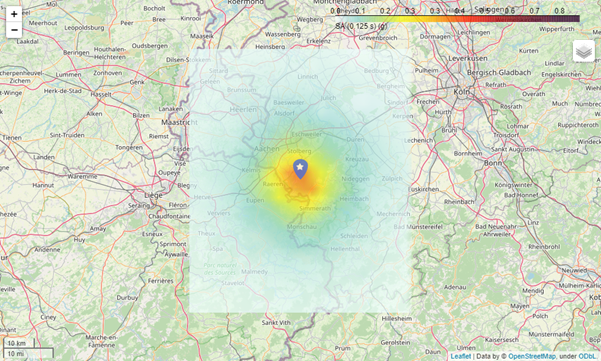Background
Realistic ground-motion modeling is in high demand for deterministic and probabilistic seismic hazard assessments (SHAs) for critical infrastructures as well as for the upcoming revision of the Eurocode 8 building code. The current practice in Belgium is to apply ground-motion prediction equations (GMPEs), which predict peak-ground motion and response spectra as a function of earthquake magnitude, distance, and possibly other source, path and site parameters (see Figure 1). Many GMPEs are available in literature, but most are representative of more active regions near plate boundaries, where ground-motion data cover a wide range of magnitudes and distances. Very few GMPEs are valid for intraplate areas like Belgium, where crustal attenuation is typically weaker, but seismic activity is much lower and data hence more sparse. Because of this lack of data, SHAs have to rely on GMPEs developed for other parts of the world, the validity of which has not been tested for our regions. However, although the vast majority of data recorded in Belgium concern weak-motion recordings of ground velocity from earthquakes with magnitudes lower than the range of interest in SHA (M≥4.5), it is clear that these data have so far been underexploited
Objectives
BELSHAKE aims to build a solid base for earthquake ground-motion modeling in Belgium. This will be achieved by (1) building a database of earthquake ground motions for Belgium and adjacent areas, and (2) developing the capacity to model ground motion due to earthquakes in Belgium. The first part of the project will be devoted to a systematic inventory of digital broadband and accelerometer records of local and regional earthquakes by stations of the Belgian seismic network, and determination of corresponding ground-motion parameters according to internationally established standards. In the second part of the project, the collected data will be used to characterize seismic attenuation in the main crustal domains in Belgium, to evaluate the validity of existing ground-motion models and finally to guide modeling of ground-motion spectra. Ultimately, this should lead to the development of a stochastic ground-motion model that is valid for Belgium, or else to the calibration of regionally adaptable (so-called “backbone”) ground-motion models, which will complement an informed selection of existing models that can be applied in our region.
Methodology
The methodological approach in the first step consists of the selection of ground-motion records according to well-defined criteria, implementation of a uniform processing flow to the selected waveforms adhering to the current best practices, quality control to exclude poor-quality records, computation of a broad range of useful intensity measures, and collection in a structured database together with reliable and comprehensive metadata. The second step involves different methodologies: first we need to characterize crustal attenuation by analyzing the high-frequency spectral decay parameter κ (kappa) from acceleration Fourier amplitude spectra (FAS) for the main crustal domains in Belgium. Secondly, we will compare ground-motion values computed from the database with values predicted by a selection of published GMPEs that are assumed to be valid for stable regions like Belgium. This comparison will be done both visually and based on statistical tests. Finally, we will model the source, path and site components of acceleration FAS, compute the corresponding response spectra, and iteratively constrain the range of poorly known parameters (e.g., stress drop) giving the best match with the collected ground-motion data. This information will then be used to develop a stochastic GMPE or, if the constrained range of the spectrum turns out to be insufficient, to calibrate a suitable backbone GMPE.

